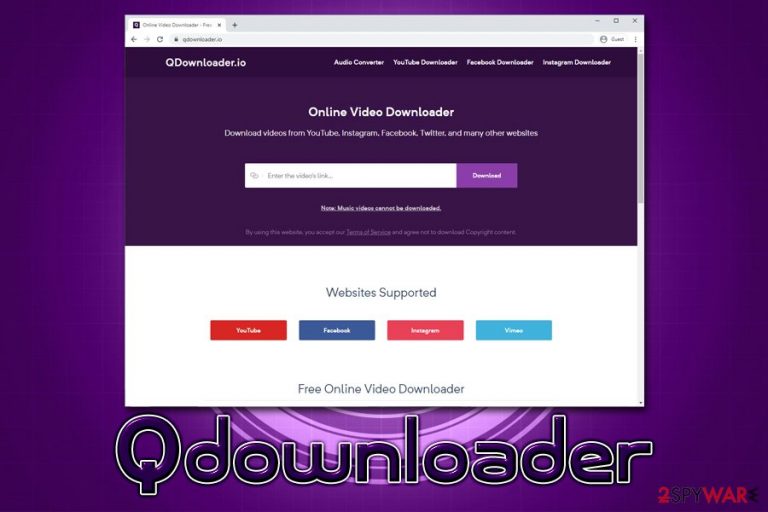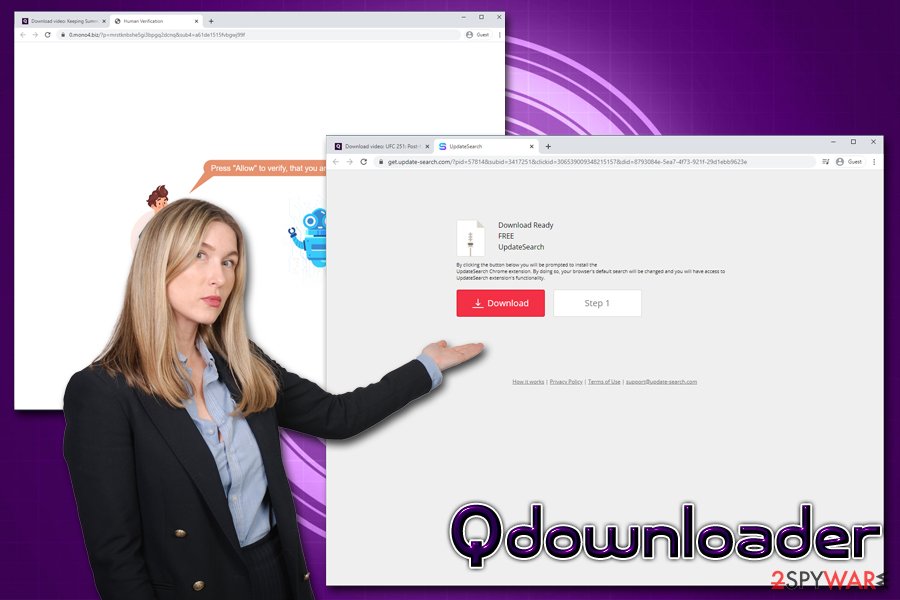Qdownloader virus (Free Guide) - Chrome, Firefox, IE, Edge
Qdownloader virus Removal Guide
What is Qdownloader virus?
Qdownloader – an online YouTube video downloading service that might infect your computer with malware

Qdownloader virus is a term used by users to describe malicious activity coming from a video downloading website qdownloader.io. Users are promised a service that allows them to convert and download videos from YouTube, Instagram, Facebook, Twitter, and other popular websites. The lack of a download button next to videos that are posted on these popular sites is what fuels these converting websites, and this one is just one of the thousands created, each benefiting from ad revenue.
While such websites might seem useful, it is important to know that they often utilize unsafe affiliates and advertising networks, which results in users seeing frequent pop-ups, redirects, fake updates, push notification prompts, and other unwanted content. At best, these ads can be annoying to deal with, and at worst, they could be the reason why users get infected with a virus, which can range from unwanted ads to threats like ransomware.
| Name | Qdownloader or Online Video Downloader |
| Type | Redirect virus, adware |
| Official websites | qdownloader.io, qdownloader.net |
| Concerns |
|
| Safety | The safety of video conversion websites is typically low, as deceptive techniques and fake ads might be often used to make users download potentially unwanted programs or malware |
| Elimination | The removal process depends on the type of the infection (notifications can be eliminated via web browser settings; PUPs can be uninstalled manually; malware should be terminated with the help of powerful anti-malware program |
| Virus damage fix | In case you got infected with malware, you should also employ PC repair tools such as FortectIntego to get rid of the infection consequences (computer slowdowns, crashes, BSODs, lag, stuttering, etc.) |
This is one of many websites that allow users to download videos from YouTube and other sites (for example, Online Video Converter, Mp3hub, Flvto, and many others). However, there is a reason why original websites do not provide download buttons – mainly because of copyright infringement policies. While listening to a music video for free is completely acceptable, downloading it on your phone would be illegal, as music is not generally free – the same goes for TV shows and movies.
As a result, many video converting sites started being shut down, as many users download videos they are not supposed to. Nevertheless, the service itself is not illegal, as long as it is used to convert and download videos that are not copyrighted. In essence, the conversion service is similar to torrenting, and many websites, such as 1337x.to, exist to this day.
However, copyright infringement is not the only issue that affects the this website. As soon as you enter the URL of the video into the search bar, you will be immediately redirected several times to some other domain. In many cases, you will land on a site that asks you to enable notifications – various deception techniques are used, for example, the website asks you to press “Allow” and confirm that you are not a robot.

Eventually, you might land on a destination site that promotes unknown browser extensions or suspicious apps. We encountered the following message which promoted a well-known browser hijacker known as UpdateSearch:
Download Ready
FREE
UpdateSearchBy clicking the button below you will be prompted to install the UpdateSearch Chrome extension. By doing so, your browser's default search will be changed and will have access to UpdateSearch extension's functionality.
Download Step 1
Please be aware that you should never download and install apps from such redirects, as you might end up infecting your machine with severe malware, such as ransomware. As a result, malware removal might be complicated, and it might also result in permanent personal file loss, sensitive information disclosure to cybercriminals, and other dangerous consequences.
In case you enabled notifications via one of the sites you got redirected to, you can remove Qdownloader ads and pop-ups by accessing the settings of your web browser – we explain how to do that below. Besides, if you interacted with the site in many different ways or downloaded something, you should also scan the machine with powerful anti-malware software and then utilize a repair program like FortectIntego – it could help you get your computer up and running smoothly again after the infection.
Potentially unwanted programs and malware avoidance techniques
There is a huge misconception about the security of computers – users believe that infecting the device with PUPs or malware is almost impossible. Besides, the mentality of “if it happens to somebody else, it does not mean that it will happen to me” does not help at all. As a result, users neglect secure web browsing practices and security advice from experienced security researchers.[1]
To protect your machine from nasties, you should employ secure web browsing practices and automated tools that could help you to protect the computer from invisible threats. Many people believe that malware infection is always visible – it displays pop-ups, BSODs,[2] and other strange behavior. However, hackers are sophisticated individuals, and they write code that runs silently in the background without crashing the machine or disclosing its presence in other ways. As a result, your PC might be infected with a Trojan or other stealthy malware for weeks or months until it is discovered.
Thus, be attentive while you browse the internet and download new programs. If possible, always choose official download sources for the software and avoid third-parties. In case you insist on downloading apps from high-risk sites, you should always watch out for fake “Download” buttons, software bundle components (use “Advanced” settings instead of “Recommended” at all times) fake Flash update prompts or virus alerts, etc.
Finally, employ comprehensive security software that would repel potentially unwanted programs, malicious apps, and prevent access to malicious JavaScript sites[3] that are engineered to download malware automatically.

Get rid of Qdownloader virus by following these instructions
As already mentioned above, the elimination process differs, depending on your actions performed when visiting the website or converting videos. For future reference, we advise you to avoid websites that offer free video conversion services, as these sites can be dangerous and result in severe malware infection. In fact, there is a chance that your machine for infected with a silent malicious program that is running in the background without displaying any symptoms.
Thus, the first step to remove adware is to perform a full system scan with powerful anti-malware software. In case you installed potentially unwanted applications that belong to scareware or similar categories, a security tool would immediately flag them and eliminate them for you automatically. Besides, anti-virus will also check for invisible threats that would otherwise steal sensitive user data or install other malware on the device.
Since Qdownloader redirects often lead to suspicious site notifications being enabled, we recommend performing a full web browser reset. Alternatively, you can also stop notifications from a particular website by following these instructions:
Google Chrome
- Press Menu > Settings
- Locate Privacy and security section and click on Site Settings
- Under Allow section, you should see the unwanted URL
- Click More Actions and then select Block.
Mozilla Firefox
- Go to Menu > Options
- Select Privacy & Security section
- Under Permissions, click Settings near Notifications section
- In the Settings – Notification Permissions window, select the drop down menu
- Select Block and then Save Changes.
Safari
- Select Safari > Preferences…
- Under Websites tab, choose Notifications
- Click on the web address and then select Deny.
You may remove virus damage with a help of FortectIntego. SpyHunter 5Combo Cleaner and Malwarebytes are recommended to detect potentially unwanted programs and viruses with all their files and registry entries that are related to them.
Getting rid of Qdownloader virus. Follow these steps
Uninstall from Windows
To uninstall unwanted apps from Windows, access Programs and Features section via the Control Panel:
Instructions for Windows 10/8 machines:
- Enter Control Panel into Windows search box and hit Enter or click on the search result.
- Under Programs, select Uninstall a program.

- From the list, find the entry of the suspicious program.
- Right-click on the application and select Uninstall.
- If User Account Control shows up, click Yes.
- Wait till uninstallation process is complete and click OK.

If you are Windows 7/XP user, proceed with the following instructions:
- Click on Windows Start > Control Panel located on the right pane (if you are Windows XP user, click on Add/Remove Programs).
- In Control Panel, select Programs > Uninstall a program.

- Pick the unwanted application by clicking on it once.
- At the top, click Uninstall/Change.
- In the confirmation prompt, pick Yes.
- Click OK once the removal process is finished.
Delete from macOS
Remove items from Applications folder:
- From the menu bar, select Go > Applications.
- In the Applications folder, look for all related entries.
- Click on the app and drag it to Trash (or right-click and pick Move to Trash)

To fully remove an unwanted app, you need to access Application Support, LaunchAgents, and LaunchDaemons folders and delete relevant files:
- Select Go > Go to Folder.
- Enter /Library/Application Support and click Go or press Enter.
- In the Application Support folder, look for any dubious entries and then delete them.
- Now enter /Library/LaunchAgents and /Library/LaunchDaemons folders the same way and terminate all the related .plist files.

Remove from Microsoft Edge
Delete unwanted extensions from MS Edge:
- Select Menu (three horizontal dots at the top-right of the browser window) and pick Extensions.
- From the list, pick the extension and click on the Gear icon.
- Click on Uninstall at the bottom.

Clear cookies and other browser data:
- Click on the Menu (three horizontal dots at the top-right of the browser window) and select Privacy & security.
- Under Clear browsing data, pick Choose what to clear.
- Select everything (apart from passwords, although you might want to include Media licenses as well, if applicable) and click on Clear.

Restore new tab and homepage settings:
- Click the menu icon and choose Settings.
- Then find On startup section.
- Click Disable if you found any suspicious domain.
Reset MS Edge if the above steps did not work:
- Press on Ctrl + Shift + Esc to open Task Manager.
- Click on More details arrow at the bottom of the window.
- Select Details tab.
- Now scroll down and locate every entry with Microsoft Edge name in it. Right-click on each of them and select End Task to stop MS Edge from running.

If this solution failed to help you, you need to use an advanced Edge reset method. Note that you need to backup your data before proceeding.
- Find the following folder on your computer: C:\\Users\\%username%\\AppData\\Local\\Packages\\Microsoft.MicrosoftEdge_8wekyb3d8bbwe.
- Press Ctrl + A on your keyboard to select all folders.
- Right-click on them and pick Delete

- Now right-click on the Start button and pick Windows PowerShell (Admin).
- When the new window opens, copy and paste the following command, and then press Enter:
Get-AppXPackage -AllUsers -Name Microsoft.MicrosoftEdge | Foreach {Add-AppxPackage -DisableDevelopmentMode -Register “$($_.InstallLocation)\\AppXManifest.xml” -Verbose

Instructions for Chromium-based Edge
Delete extensions from MS Edge (Chromium):
- Open Edge and click select Settings > Extensions.
- Delete unwanted extensions by clicking Remove.

Clear cache and site data:
- Click on Menu and go to Settings.
- Select Privacy, search and services.
- Under Clear browsing data, pick Choose what to clear.
- Under Time range, pick All time.
- Select Clear now.

Reset Chromium-based MS Edge:
- Click on Menu and select Settings.
- On the left side, pick Reset settings.
- Select Restore settings to their default values.
- Confirm with Reset.

Remove from Mozilla Firefox (FF)
In case you can't eliminate certain browser extensions or encounter other difficulties, reset Mozilla Firefox as explained below:
Remove dangerous extensions:
- Open Mozilla Firefox browser and click on the Menu (three horizontal lines at the top-right of the window).
- Select Add-ons.
- In here, select unwanted plugin and click Remove.

Reset the homepage:
- Click three horizontal lines at the top right corner to open the menu.
- Choose Options.
- Under Home options, enter your preferred site that will open every time you newly open the Mozilla Firefox.
Clear cookies and site data:
- Click Menu and pick Settings.
- Go to Privacy & Security section.
- Scroll down to locate Cookies and Site Data.
- Click on Clear Data…
- Select Cookies and Site Data, as well as Cached Web Content and press Clear.

Reset Mozilla Firefox
If clearing the browser as explained above did not help, reset Mozilla Firefox:
- Open Mozilla Firefox browser and click the Menu.
- Go to Help and then choose Troubleshooting Information.

- Under Give Firefox a tune up section, click on Refresh Firefox…
- Once the pop-up shows up, confirm the action by pressing on Refresh Firefox.

Remove from Google Chrome
Delete malicious extensions from Google Chrome:
- Open Google Chrome, click on the Menu (three vertical dots at the top-right corner) and select More tools > Extensions.
- In the newly opened window, you will see all the installed extensions. Uninstall all the suspicious plugins that might be related to the unwanted program by clicking Remove.

Clear cache and web data from Chrome:
- Click on Menu and pick Settings.
- Under Privacy and security, select Clear browsing data.
- Select Browsing history, Cookies and other site data, as well as Cached images and files.
- Click Clear data.

Change your homepage:
- Click menu and choose Settings.
- Look for a suspicious site in the On startup section.
- Click on Open a specific or set of pages and click on three dots to find the Remove option.
Reset Google Chrome:
If the previous methods did not help you, reset Google Chrome to eliminate all the unwanted components:
- Click on Menu and select Settings.
- In the Settings, scroll down and click Advanced.
- Scroll down and locate Reset and clean up section.
- Now click Restore settings to their original defaults.
- Confirm with Reset settings.

Delete from Safari
Remove unwanted extensions from Safari:
- Click Safari > Preferences…
- In the new window, pick Extensions.
- Select the unwanted extension and select Uninstall.

Clear cookies and other website data from Safari:
- Click Safari > Clear History…
- From the drop-down menu under Clear, pick all history.
- Confirm with Clear History.

Reset Safari if the above-mentioned steps did not help you:
- Click Safari > Preferences…
- Go to Advanced tab.
- Tick the Show Develop menu in menu bar.
- From the menu bar, click Develop, and then select Empty Caches.

After uninstalling this potentially unwanted program (PUP) and fixing each of your web browsers, we recommend you to scan your PC system with a reputable anti-spyware. This will help you to get rid of Qdownloader registry traces and will also identify related parasites or possible malware infections on your computer. For that you can use our top-rated malware remover: FortectIntego, SpyHunter 5Combo Cleaner or Malwarebytes.
How to prevent from getting adware
Stream videos without limitations, no matter where you are
There are multiple parties that could find out almost anything about you by checking your online activity. While this is highly unlikely, advertisers and tech companies are constantly tracking you online. The first step to privacy should be a secure browser that focuses on tracker reduction to a minimum.
Even if you employ a secure browser, you will not be able to access websites that are restricted due to local government laws or other reasons. In other words, you may not be able to stream Disney+ or US-based Netflix in some countries. To bypass these restrictions, you can employ a powerful Private Internet Access VPN, which provides dedicated servers for torrenting and streaming, not slowing you down in the process.
Data backups are important – recover your lost files
Ransomware is one of the biggest threats to personal data. Once it is executed on a machine, it launches a sophisticated encryption algorithm that locks all your files, although it does not destroy them. The most common misconception is that anti-malware software can return files to their previous states. This is not true, however, and data remains locked after the malicious payload is deleted.
While regular data backups are the only secure method to recover your files after a ransomware attack, tools such as Data Recovery Pro can also be effective and restore at least some of your lost data.
- ^ Senzavirus. Senzavirus. Cybesecurity advice and malware insights.
- ^ Blue screen of death. Wikipedia. The free encyclopedia.
- ^ Andra Zahara. JavaScript Malware – a Growing Trend Explained for Everyday Users. Heimdal Security. Security blog.
